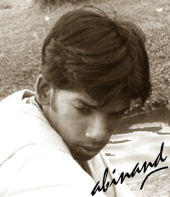SIMULACRA & SIMULATION
Saturday, August 06, 2005

After spending months searching for this book 'Simulacra & Simulations', I finally managed to 'get hold of it'. Yeah! It IS a book; I can read it; I can even bookmark the pages. But is it really a 'book'? Can I touch it? No! Because after much of a search, what I got was an E-book- a simulation of the actual book!
' simulate v.tr. 1 a pretend to have or feel( an attribute or feeling). b pretend to be. 2 imitate or counterfeit.'
This is how The Oxford Dictionary defines the word 'simulation'. Everyone is of the idea that to simulate is to feign to have what one hasn't.But the matter is more complicated, since to simulate is not simply to feign. In his book 'Simulacra & Simulations', Jean Baudrillard says that the words 'feign' and 'simulate' have a thin strand of difference between them.
"Someone who feigns an illness can simply go to bed and make believe he is ill. Someone who simulates an illness produces in himself some of the symptoms", he argues. This kindles an interest to know more about this book.
'Simulacra & Simulations' is a French book written by Jean Baudrillard, translated in English by Sheila Faria Glaser and made famous by movies like 'The Matrix'. The book covers many topics like Nihilism, psychoanalysis, politics, world wars etc. with respect to 'Simulacrum'. One of the most interesting areas of the book is where the author knowingly or unknowingly explains Chaos theory.(Look out for articles on Chaos theory in the months to come.)
The essence of chaos theory, known as sensitive dependence on initial conditions, states that just a small change in the initial conditions can drastically change the long-term behavior of a system. This is exactly what Jean Baudrillard says in his book. He states there there is nothing called 'A perfect simulation'.For eg. Go and simulate a theft in a large department store. How do you convince the security guards that it is a simulated theft? There is no "objective" difference: the same gestures and the same signs exist as for a real theft; in fact the signs incline neither to one side nor the other. As far as the established order is concerned, they are always of the order of the real.
Go and organise a fake hold-up. Be sure to check that your weapons are harmless, and take the most trustworthy hostage, so that no life is in danger (otherwise you risk committing an offence). Demand ransom, and arrange it so that the operation creates the greatest commotion possible - in brief, stay close to the "truth", so as to test the reaction of the apparatus to a perfect simulation. But you won't succeed: the web of artificial signs will be inextricably mixed up with real elements (a police officer will really shoot on sight; a bank customer will faint and die of a heart attack; they will really turn the phoney ransom over to you) - in brief, you will unwittingly find yourself immediately in the real, one of whose functions is precisely to devour every attempt at simulation, to reduce everything to some reality - that's exactly how the established order is, well before institutions and justice come into play.
This is just a drop in the ocean of this book. It seems complicated, but then, it talks about reality and simulations in everyday life. Since life itself is complicated, there is nothing wrong in this book being complicated. But on completing the book, one is sure to experience a revelation.
" Unfortunately, some things can't be explained. You'll have to feel it for yourself."

Saturday, August 06, 2005 10:06:00 AM
Wow.. that post really kindled my interest...
will have to start reading this book sometime :)
Monday, August 29, 2005 8:05:00 PM
hey, i've also been trying to get a hand on this book, and i wondered if you could email me your e-text. it is unlikely baudrillard would care, from what i've learned so far. grantmahoney@ameritech.net